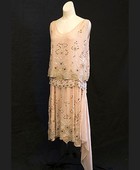
Maria Monaci-Gallenga
About
Maria Monaci was born in Italy in 1880. In 1903, she married Peter Gallenga, who was one of the first doctors specializing in Cancer treatment.
Maria was an artist who started making clothes in 1914 showing them in Rome and in Florence where her studio was located in the Via de Tornabuoni.
She frequently incorporated her signature into the pattern of her materials. She designed theatrical velvet cloaks and tea gowns, evocative of the middle ages. She drew inspiration from pre-Raphaelite works of art and showed her garments in art exhibitions. Gallenga's fabrics and garments reflect the passion for the Italianate past.
Gallenga's gowns were very much part of the 20's idiom. She was awarded with the Silver Medal at the Monza design exhibition in 1923. In 1928, Maria Gallenga along with Bice Pittoni and Carla Visconti di Modrone, founded the Boutique Italienne in Paris. It was active as a display window for Italian fashion till 1934.
Maria Gallenga died in 1944 at the age of 64.
The Look
Worn at a theatre opening in New York in 1916, a Gallenga "moyen age" gown attracted much notice for it's miraculous gold pattern which appeared to float on the weightless black silk and did not seem to be painted or woven. Such a garment became a Gallenga signature. These gowns had square, boat or V necklines, tong tapered or paneled sleeves and often panels of floating chiffon set into their side seams. This 1916 tunic is made of gold silk embroidered in white at the neck and hem with orange crepe-de-Chine wrap stenciled in gold. They had Venetian glass mille fiore beads, sewn at the shoulders or sometimes at the wrist or hem. These beads were larger and heavier than those used by Fortuny. For these gowns Gallenga used silk velvet or crepe de Chine, sometimes dyed in ombre shadings and stenciled with up to 9 tons of gold and silver paint. Her husband, Peter Gallenga, was a professor at the University of Rome, who helped her devise the method by which the metallic paint seemed to float on the fabric, not tarnishing or flaking off. This stenciling which did not affect the depth of the velvet's pile, was applied in a variety of patterns. Most popular was a Gothic ironwork-inspired design of ovals, inside of which were birds and flowers.